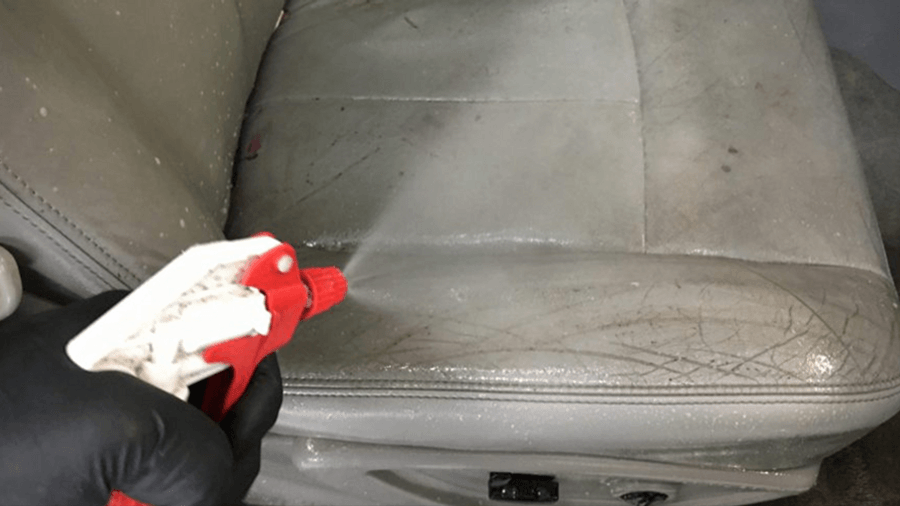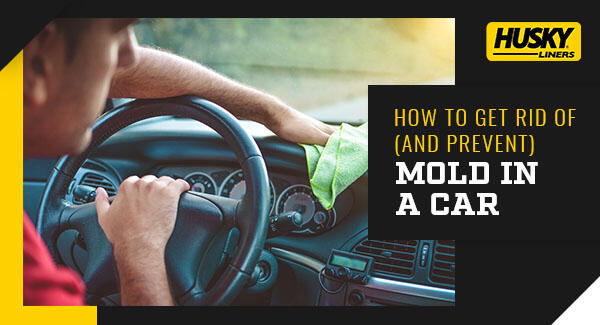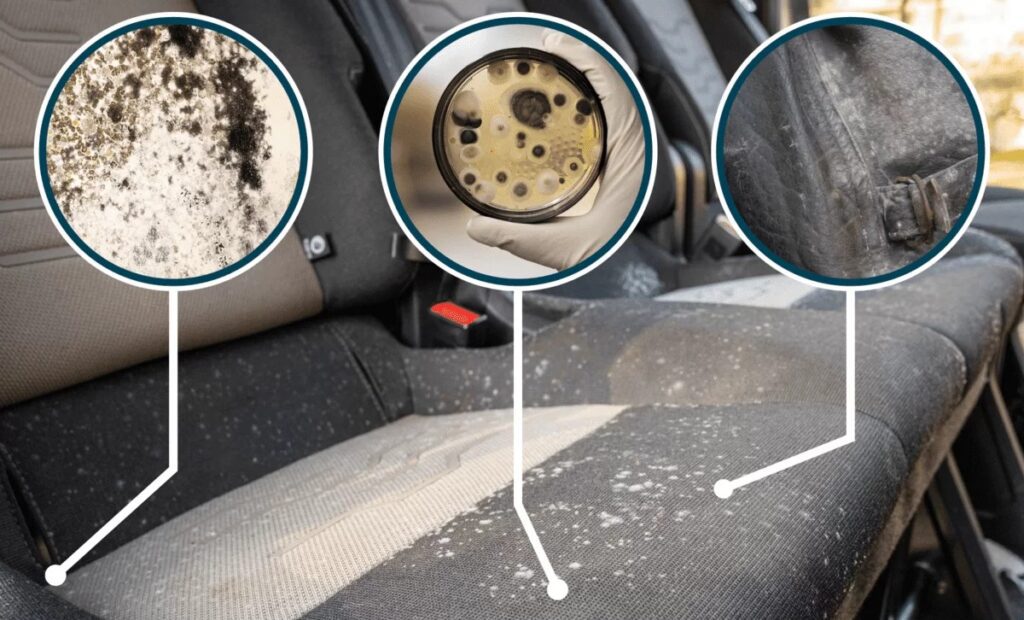Have you ever dealt with the frustrating problem of mold returning in your car interior? If so, you’re not alone. Mold can quickly take over your car seats, carpets, and upholstery, leaving behind an unpleasant smell and potentially causing health issues. But fear not, because we have the solution for you. Our revolutionary product, “How To Prevent Mold From Returning In Your Car Interior?” provides you with a simple and effective method to keep mold at bay. Say goodbye to moldy car interiors and hello to a fresh and clean driving experience.

Properly Cleaning Your Car
Vacuuming the Interior
One of the first steps in properly cleaning your car is vacuuming the interior. Start by removing any loose items such as trash, papers, or random belongings that may have accumulated over time. Then, using a handheld or regular vacuum cleaner with various attachments, thoroughly vacuum all surfaces including the seats, floors, and dashboard. Pay extra attention to hard-to-reach areas such as crevices and seat seams where dirt and debris tend to accumulate.
Removing Trash and Moisture
To prevent mold from returning, it is crucial to remove any trash or food waste from your car regularly. Leftover food or spilled drinks can attract moisture and provide a breeding ground for mold. Make it a habit to empty the trash bag often and sanitize the interior with mild cleaning products to get rid of any lingering smells.
Additionally, it’s important to address any sources of moisture in your car. Check for any open windows or sunroof leaks and fix them promptly. Moisture can seep into your car’s interior and create a perfect environment for mold growth.
Cleaning Upholstery and Carpets
Upholstery and carpets are often prone to accumulating dirt, dust, and even mold spores. To clean them effectively, start by spot cleaning any visible stains using a mixture of mild detergent and water. Gently scrub the stained area with a soft brush, being careful not to saturate the fabric. For a more thorough cleaning, use a carpet cleaner or a steam cleaner to lift and remove deep-seated dirt and potential mold spores.
Cleaning Leather Surfaces
If your car has leather surfaces, it’s important to clean and maintain them properly. Leather can be prone to drying out and cracking, especially if exposed to moisture. Start by wiping down the surfaces with a soft, damp cloth to remove any dirt or grime. Then, using a leather conditioner, gently massage it into the leather to restore moisture and prevent it from drying out. Regularly conditioning the leather will not only keep it looking good but also prevent mold from forming.
Wiping Down Hard Surfaces
In addition to vacuuming and cleaning upholstery, it’s essential to wipe down all hard surfaces in your car. This includes the dashboard, steering wheel, door handles, and any other plastic or vinyl surfaces. Use a gentle cleaner and a microfiber cloth to remove dust, dirt, and potential mold spores. Regularly wiping down these surfaces will not only keep your car looking clean but also help prevent the growth of mold.
Controlling Humidity
Using a Dehumidifier
One effective way to control humidity and prevent mold in your car is by using a dehumidifier. Portable dehumidifiers can help remove excess moisture from the air, making it less conducive for mold to grow. Place the dehumidifier in your car, ideally overnight, to effectively reduce the humidity level. Remember to empty the water reservoir regularly to prevent any potential spills.
Leaving Windows Open for Ventilation
Another simple yet effective way to control humidity is by leaving your car’s windows slightly open when parked. This allows for better airflow and reduces the chance of moisture buildup, especially if you live in a humid climate. However, exercise caution and ensure that the windows are not left too wide open to prevent theft or water damage in case of rain.
Using Moisture Absorbers
Moisture absorbers, such as silica gel packets or activated charcoal, can be placed in your car to help absorb excess moisture and prevent mold growth. These products are readily available and can be easily placed in cupholders, under seats, or in other areas prone to moisture buildup. Make sure to replace or recharge them regularly according to the manufacturer’s instructions.
Avoiding Wet Items in the Car
To minimize the risk of mold growth, it’s important to avoid bringing wet items into your car. Wet clothes, shoes, or umbrellas can introduce moisture into the interior and create an ideal environment for mold to thrive. If you must transport wet items, try to place them in a waterproof bag or container to contain the moisture and prevent it from seeping into your car’s surfaces.
Regular Maintenance
Inspecting and Fixing any Water Leaks
Regularly inspecting your car for water leaks is crucial in preventing mold from returning. Check for signs of water damage, such as wet spots, musty smells, or dampness. If you notice any leaks, it’s essential to address them promptly. Thoroughly inspect the seals around windows, sunroofs, and doors and replace them if necessary. Ignoring water leaks can lead to further mold growth and potential damage to your car’s interior.
Checking and Cleaning A/C Drain Tubes
Your car’s air conditioning system produces condensation which is typically drained through small tubes. Over time, these drain tubes can become clogged with debris, leading to water buildup and potential mold growth. Regularly check the A/C drain tubes and clean them using a pipe cleaner or a similar tool to ensure proper drainage of moisture.
Cleaning and Maintaining Sunroof Drains
If your car has a sunroof, it’s important to maintain the sunroof drains to prevent water from pooling and causing mold growth. Regularly inspect the sunroof drains and remove any debris or blockages. You can use compressed air or a small wire to gently clear the drains. Taking these preventive measures will minimize the risk of water intrusion and subsequent mold infestation.
Regularly Changing Cabin Air Filters
Cabin air filters are designed to filter out dust, pollen, and other airborne particles before they enter your car’s interior. Over time, these filters can become clogged with dirt and even mold spores. Regularly check your car’s cabin air filter and change it according to the manufacturer’s recommendations. Keeping a clean air filter will not only improve air quality but also reduce the likelihood of mold growth.
Proper Storage
Parking in a Dry and Well-Ventilated Area
When storing your car, whether it’s for a few days or an extended period, it’s crucial to choose a dry and well-ventilated area. Avoid parking your car in damp or humid environments, as this can increase the risk of mold growth. If possible, park your car in a garage, carport, or covered area that provides protection from the elements.
Using Car Covers or Sunshades
Covering your car with a breathable car cover or using sunshades can help protect it from direct sunlight and potential moisture. Sunshades can prevent excessive heat buildup, while car covers provide an extra layer of protection against dust, dirt, and moisture. Make sure to choose a breathable cover or sunshade to allow for proper airflow and prevent condensation.
Avoiding Long-Term Storage of Wet Items
If you plan on storing items in your car, such as camping gear or wet beach towels, make sure they are completely dry before placing them inside. Any residual moisture can lead to mold growth, especially in an enclosed space. Allow wet items to fully dry outside the car before storing them to minimize the risk of mold infestation.

Eliminating Food and Beverage Sources
Avoid Eating or Drinking in the Car
One effective way to prevent mold from returning is by avoiding eating or drinking in your car. Food crumbs, spilled drinks, and even leftover containers can create an inviting environment for mold to grow. If you must eat or drink in your car, make sure to clean up immediately afterward and dispose of any food waste properly.
Properly Dispose of Food Waste
When you do have food waste in your car, such as empty snack bags or fast-food wrappers, it’s important to dispose of them properly. Keep a small trash bag or container in your car and make it a habit to empty it regularly. Properly disposing of food waste will not only help prevent mold but also keep your car clean and odor-free.
Regularly Clean Beverage Spills
If you accidentally spill a drink in your car, it’s crucial to clean it up promptly. Use a clean cloth or paper towel to blot the spilled liquid and absorb as much as possible. Then, clean the area with a mild detergent or upholstery cleaner to remove any potential stains and prevent mold growth.
Emptying and Cleaning the Cupholders
Cupholders are often overlooked when cleaning the car’s interior, yet they can harbor spills, crumbs, and moisture. Regularly empty and clean the cupholders using a damp cloth and mild detergent. This will help remove any potential food or drink residue and reduce the risk of mold growth.
Dealing with Moisture-Prone Areas
Cleaning and Drying Floor Mats
Floor mats are particularly prone to moisture buildup due to wet shoes or spills. Regularly remove the floor mats and shake off any loose dirt or debris. If the mats are wet or damp, ensure they are thoroughly dried before placing them back in the car. You can hang them to dry or use a fan to expedite the drying process.
Removing Wet or Damp Items
If you accidentally leave wet items in your car, such as wet clothes or beach towels, it’s essential to remove them promptly. Take them out of the car and allow them to thoroughly dry before returning them. Leaving wet or damp items in your car can contribute to moisture buildup and increase the risk of mold growth.
Addressing Mold in Trunk or Storage Compartments
Mold can also develop in your car’s trunk or storage compartments if moisture is present. Regularly inspect these areas for signs of mold, such as a musty smell or visible patches. If you notice mold, take immediate action to address it. Remove any affected items, thoroughly clean and disinfect the area, and ensure it is completely dry before putting anything back in the trunk or storage compartments.

Using Mold-Inhibiting Products
Applying Mold and Mildew Sprays
Mold and mildew sprays can be a helpful tool in preventing mold growth in your car’s interior. These products contain ingredients that inhibit mold and mildew formation. Follow the manufacturer’s instructions and apply the spray to areas prone to moisture or mold growth, such as carpets, upholstery, and door panels. Regular application can provide an extra layer of protection against mold infestation.
Using Anti-Moisture Products
Anti-moisture products, such as moisture absorbers or desiccants, can help regulate humidity levels in your car and prevent condensation. These products come in various forms, including pouches, packets, or dehumidifier bags. Place them in areas where moisture buildup is common, such as the trunk, storage compartments, or under seats. Regularly check these products and replace them as needed.
Using Mold-Resistant Seat Covers
If you want to add an extra layer of protection to your car’s seats, consider using mold-resistant seat covers. These covers are designed to repel moisture and inhibit the growth of mold and mildew. They are available in various materials and designs, allowing you to choose an option that suits your preferences and style. Regularly clean and treat the seat covers according to the manufacturer’s instructions to maintain their effectiveness.
Ventilating the Car Interior
Keeping Windows Slightly Open
Proper ventilation is key to controlling humidity and preventing mold growth in your car. Whenever possible, keep your car’s windows slightly open, allowing fresh air to circulate and reducing the risk of moisture buildup. This is particularly important on humid or rainy days when condensation can quickly accumulate.
Using Air Conditioning and Ventilation System
Utilizing your car’s air conditioning and ventilation system is crucial in maintaining a dry and mold-free interior. Regularly run the air conditioning at a comfortable temperature to help remove excess humidity from the air. Use the “recirculation” mode sparingly to prevent stale air and consider leaving the vents open to allow fresh air to enter.
Running the Heater on Hot Days
On hot and humid days, running the car’s heater for a short period can help reduce moisture and dry out the interior. Turn the temperature to the highest setting and direct the airflow toward the floor or the rear window. This will help evaporate any excess moisture and discourage mold growth.

Regular Cleaning and Maintenance Schedule
Establishing a Cleaning Routine
To effectively prevent mold from returning, it’s important to establish a regular cleaning routine for your car. Create a schedule that works for you, whether it’s cleaning once a week or bi-weekly. Stick to this routine and focus on the areas prone to moisture and mold growth. Regular cleaning will not only keep your car looking its best but also help maintain a healthy and mold-free environment.
Scheduled Maintenance for Mold Prevention
In addition to regular cleaning, it’s essential to include scheduled maintenance tasks in your mold prevention efforts. Regularly inspect and address any potential water leaks, clean and maintain A/C drain tubes and sunroof drains, and change cabin air filters according to the manufacturer’s recommendations. By incorporating these tasks into your maintenance schedule, you can effectively minimize the risk of mold growth in your car.
Professional Cleaning and Treatment
Seeking Professional Mold Remediation
If you notice severe mold infestation in your car or have tried various DIY methods without success, it may be time to seek professional mold remediation services. Mold remediation experts have the knowledge, experience, and specialized equipment to effectively remove mold and restore your car’s interior. Contact a reputable professional and discuss your specific needs to ensure a thorough and successful mold removal process.
Upholstery and Carpet Cleaning Services
Professional upholstery and carpet cleaning services can be beneficial in maintaining a mold-free car interior. These services utilize specialized equipment and cleaning solutions to deep clean and sanitize your car’s upholstery and carpets. Consider scheduling periodic deep cleaning sessions to ensure that any potential mold spores are removed, leaving your car fresh and mold-free.
Treatment by Auto Detailing Experts
Auto detailing experts are skilled in restoring and maintaining the appearance and cleanliness of your car’s interior. They can offer specialized treatments and services to prevent and address mold growth. From steam cleaning to applying protective treatments, these professionals can help keep your car’s interior in top condition. Research and choose a reputable auto detailing service to ensure optimal results.
By following these comprehensive techniques and maintaining a regular cleaning and maintenance routine, you can effectively prevent mold from returning in your car’s interior. Remember to address moisture issues promptly, properly clean any spills or stains, and create a well-ventilated environment to minimize the risk of mold growth. Keeping your car clean and mold-free not only improves its appearance but also promotes a healthier and more enjoyable driving experience.
